Журнал «Боль. Суставы. Позвоночник» 1 (21) 2016
Вернуться к номеру
Zoledronic acid in the therapy of steroid-induced osteoporosis in patients with inflammatory joints disease
Авторы: Mytrokhina O. - Dnipropetrovsk Medical Academy, Dnipropetrovsk, Ukraine; Lysunets T. - Regional Hospital after I.I. Mechnikov, Dnipropetrovsk, Ukraine
Рубрики: Ревматология, Травматология и ортопедия
Разделы: Медицинские форумы
Версия для печати
The article was published on p. 79-80
Osteoporosis is the most common bone disease in humans, representing a major public health problem as outlined in Bone Health and Osteoporosis. The disease characterized by low bone mass and microarchitectural deterioration of bone tissue, with a consequent increase in bone fragility. The disease often does not become clinically apparent until a fracture occurs. Although glucocorticosteroids may effectively be used in the management of many inflammatory conditions, their use is associated with significant morbidity and mortality. The bone loss and increased fracture risk are a common consequence of using glucocorticosteroid drugs. The most pressing issue remains the prevention of osteoporosis in patients with prolonged therapy by glucocorticosteroid. Oral bisphosphonates increase bone mineral density and reduce frequency of vertebral fractures. The role of Zoledronic acid (ZOL) for steroid-induced osteoporosis in patients with inflammatory joints disease remains debatable.

